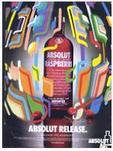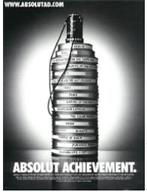From the frogs of Bud Light to the glossy Bacardi ads, the major alcohol industry media campaigns have gained massive popularity and pronounced cultural impact. In particular, the innovative Absolut advertisements are internationally famous. This popular brand of vodka is the only alcohol product whose advertising the American Marketing Association deemed worthy of including in its Hall of Fame (www.absolutad.com). Fusing popular culture with witty statements like “Absolut Perfection,” the ads are collectors’ items. Websites such as www.absolutad.com and www.absolutad.org and books, Richard W. Lewis’s Absolut Book, cater to this growing interest in Absolut ad icons.
The Absolut marketing campaign took a unique angle by working with the fashion and art worlds. Participating in the creation of an ad or being featured in an ad has become prestigious and noteworthy. For example, artist Henji Hirata designed this Absolut Raspberri ad. Absolut encourages artists to submit their work and helps showcase their Absolut creations. One can argue that these ads transcend the advertising market where the “borders between art, fashion, PR and marketing blur” (www.absolutad.com). Some observers might even consider these Absolut ads as art: they encompass artistic expressions and continue to gain recognition in the art world. Even if one is not an Absolut ad collector, one can not ignore the presence of these ads — from bus stops to magazines.
However, these ads also might have untoward consequences. Jones & Donovan (2001) asserted that alcohol ads target youth by making their products synonymous with social success and stress reduction. Critical interpretations of the Absolute ads provide some support for this assertion. For example, in Hirata’s ad, the Absolut bottle is placed in a colorful cage-like structure with the statement, “Absolut Release.” The ad dares the viewer to “Unleash the Raspberry” and implies that drinking Absolut is liberating. Because the message is general, the Absolut drinker can project being liberated from a spectrum of situations ranging from work to social interactions. This Rasberri ad illustrates Jones and Donovan’s (2001) concept of stress reduction.
Absolut advertisements also make implications about romantic interactions. One ad publicizing the Kurant flavor displays the back of a woman in a corset with the corset’s strings shaped like the bottle. Like so many other advertisements, this ad is sexually explicit. This ad insinuates that by using their product, the viewer will be more successful with the opposite sex. Advertisers designed this ad from the male perspective; they objectified this woman because only her back is shown. However, female viewers might conclude that Absolut will make them more attractive and attract more attention from men – perhaps if they “untie” with Absolut. This ad promotes Absolut to both genders as an aid for both sexual and romantic relations. In addition, this ad easily can target the fantasies of the pubescent population because they often experience relationship anxieties.
An ad in tribute to the accomplished director Steven Spielberg shows several Spielberg film reels stacked together into an Absolut bottle shape with the message “Absolut Achievement.” Observers might interpret the ad to suggest that Absolut can be a key to success or at least a component of success. The implication is that Absolut drinkers can achieve like Spielberg and attain fame as a result. Steven Spielberg is a popular icon; by pairing him with Absolut, the ad emphasizes Absolut’s own unique worth. Or, the ad simply might be supporting the arts as it celebrates Spielberg’s films. Despite the multiple interpretations, the ad targets aspiring young people with an implicit message about the value of drinking to succeed.
What might be the repercussions of using ads to attract youth to alcohol? Several longitudinal studies examined the relationship between alcohol advertising and alcohol use. Connolly, Casswell, Zhang, & Silva (1994) found that youths who watched more television as teenagers consumed more alcohol at age 18. One possibility is that adolescents who watch more TV view more alcohol ads and this exposure elevates vulnerability. Stacy, Zogg, Unger, & Dent (2004) studied exposure to television alcohol ads and alcohol consumption. Their results showed that the teenagers who were more exposed to alcohol ads consumed more beer. Though assessing alcohol advertising’s influence on teen alcohol use is complicated by other factors such as peer pressure, Stacy et al. (2004) stressed the importance of reducing youth’s exposure to alcohol ads as a preventive measure. There is a positive association between liking alcohol advertising and alcohol consumption (Casswell & Zhang, 1998).
So what about those hip Absolut ads? Though the ads are creative and some might even consider them as art, these ads are risky to the public health because they popularize alcohol use among youth. For example, Absolut’s new campaign message, “Find Your Flavor,” has an implicit appeal to teens who are trying to find their identity, the quest of adolescence. Interestingly, it is important to note that Absolut supports AIDS research and The Gay & Lesbian Alliance Against Defamation. Although it is unreasonable to expect that Absolut will start funding alcohol and addiction related research and treatment, we hope that they will emphasize more art and de-emphasize youth in their advertising campaigns.
What do you think? Comments can be addressed to Sarbani Hazra.
References
Alaniz, M. L. (1998). "Alcohol availability and targeted advertising in racial/ethnic minority communities." Alcohol Health & Research World 22(4): 286-9.
Casswell, S. & Zhang, J. F. (1998). "Impact of liking for advertising and brand allegiance on drinking and alcohol-related aggression: a longitudinal study." Addiction 93(8): 1209-17.
Connolly, G. M., Casswell, S., Zhang, J., & Silva, P. (1994). "Alcohol in the mass media and drinking by adolescents: a longitudinal study." Addiction 89(10): 1255-63.
Elliot, S. (2001). Absolut customizes a campaign to salute the gay and lesbian alliance against defamation. The New York Times. New York City
Jones, S. C. & Donovan. R. J. (2001). "Messages in alcohol advertising targeted to youth." Australian and New Zealand Journal of Public Health 25(2): 126-31.
Stacy, A. W., Zogg, J. B., Unger, J. B., Dent, C. W. (2004). "Exposure to televised alcohol ads and subsequent adolescent alcohol use." American Journal of Health Behavior 28(6): 498-509.
AbsolutAd.com. (2005). AbsolutAd.com. Retrieved June 20, 2005, from the World Wide Web: http://absolutad.com/.
Absolut, Inc. (2005). Absolut Home. Retrieved June 23, 2005, from the World Wide Web: http://absolut.com/.
Absolut Vodka Advertising Archive. (2001). Absolut Vodka Advertising Archive. Retrieved June 21, 2005 from the World Wide Web: http://www.absolutad.org/.







